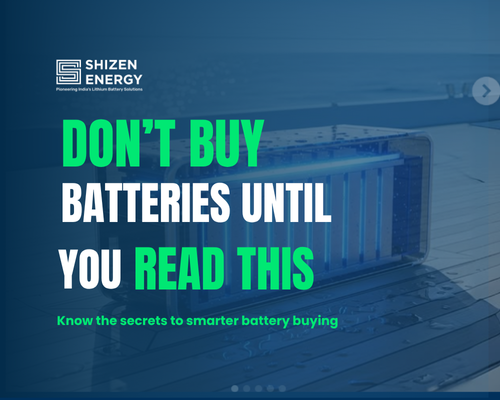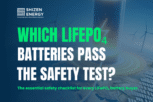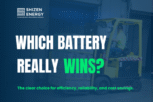
India’s electric vehicle revolution is underway and the renewable energy transition is speeding up. In this new world of clean mobility and power, fast-growing companies like Shizen Energy India Private Limited (established in 2019) are leading the battery revolution by providing advanced lithium battery packs for electric vehicles (EV), solar power, and industrial equipment.
Battery buyers and decision makers are often confused by a range of chemistries Li-ion vs LiFePO4 vs NMC (popular in China & US) and are not sure which battery to choose for their application. Battery manufacturers and EPC contractors are searching for high-performance batteries that are safe, reliable, durable, and cost-effective in the long run. In this blog, we address the best use cases for LiFePO4 batteries, and answer some frequently asked questions.
Section 1: LiFePO4 Battery Use in Electric Vehicles (EV) Why LiFePO4 Is the Best Battery for EVs
Electric vehicles (Ev) are taking over from ICE vehicles. In the short term, it’s all about golf carts, e-rickshaws, e-scooters, and e-boats. In the next 5 years, with the upcoming electric two-wheelers and small cars, the battery demand in this sector will go through the roof. The key reason for choosing a LiFePO4 battery is safety, high cycle life, ability to work well in high temperature, and the overall cost of ownership.
As the battery market in India is new and maturing, customers (prospect buyers, e-rickshaw manufacturers, EV manufacturers, OEM, EPC, etc) are often confused about the types of lithium batteries. Shizen Energy’s battery packs use LiFePO4 chemistries with our own in-house developed proprietary prismatic cells, giving better performance than traditional Li-ion pouch/Tab cells or NMC cells in the following parameters.
- Fast Charging, Higher Energy Efficiency & Minimal Idle Time: Electric vehicles such as e-rickshaws, e-bikes, and scooters are expected to operate for over 12 hours a day without interruption. Shizen Energy’s LiFePO4 battery packs, built using our in-house developed proprietary prismatic cells (PEFB), deliver up to 5X higher energy efficiency compared to traditional lead-acid batteries and support fast charging—often in just 2 hours or less. Additional advantages such as longer lifespan, zero idle time, improved power density, higher depth of discharge (DoD), and long-term service support enable greater annual utilization and stronger overall business performance.
- Safety & High Cycle Life: LiFePO4 is recognized as the safest lithium chemistry, offering almost zero risk of thermal runaway or fire when compared to NMC or conventional Li-ion batteries. With a cycle life ranging from 2,000 to 5,000+ cycles, it significantly outperforms lead-acid batteries while maintaining reliability comparable to NMC types. Passenger safety is also enhanced, making Shizen Energy’s LiFePO4 batteries a dependable choice for e-rickshaw and EV manufacturers seeking to provide secure, worry-free rides.
- Long Cycle Life, Temperature Tolerance & Thermal Stability: Delivering an impressive 2,000 to 5,000+ charge cycles, Shizen Energy’s LiFePO4 batteries outperform traditional lead-acid options and remain competitive with NMC technologies. They operate efficiently across a wide temperature range of -20°C to 60°C—a critical advantage in India’s challenging climate where high heat and frequent undercharging or recharging are common. This makes them ideal for consistent, long-term use in diverse conditions.
A Use Case in Electric Vehicle Fleets A leading e-rickshaw operator in North India had a tough choice to make – upgrade the battery in its large EV fleet. After a careful evaluation, they chose Shizen Energy’s LiFePO4 battery packs. The result? 50% longer battery life, less downtime, and safer rides for passengers. Fleet operators also reported lower maintenance costs and higher daily mileage, directly boosting their bottom line.
Real Stats (approx range from various datasheets)
- Cycle Life: 2,000 – 5,000 cycles (Lead-Acid: 500 – 1,000)
- Charging Time: 2 hours (Lead-Acid: 8–10 hours)
- Operating Temperature Range: -20°C to 60°C
Section 2: LiFePO4 Solar Battery for Solar & Off-Grid Systems Reliability & Deep Discharge Capability for Solar Applications
Solar power companies, rooftop installers, and off-grid system integrators face similar challenges in terms of battery performance and customer expectations. Solar applications need a reliable battery that can handle the daily deep discharge cycles and the varying weather conditions. For solar rooftops, the batteries need to be maintenance-free, have a long lifespan, and be eco-friendly.
LiFePO4 solar batteries are an excellent fit in these scenarios, as they can provide:
- Deep Discharge Capability: LiFePO4 solar batteries can discharge up to 80–90% of their rated capacity without significant damage or loss of capacity, unlike lead-acid batteries that can get sulfation and damage at a much lower DoD. This means more usable energy for solar rooftops and off-grid systems.
- Eco-Friendly & Maintenance-Free: LiFePO4 cells do not contain toxic heavy metals like lead, cadmium, or mercury, making them more environmentally friendly and easier to recycle. Also, unlike flooded lead-acid batteries, LiFePO4 batteries require no regular maintenance or watering.
- Long-Term Reliability: LiFePO4 batteries have a lifespan of up to 10 years, which is much longer than lead-acid batteries. This makes them a cost-effective and reliable choice for solar EPC contractors and end-users who want to reduce their total cost of ownership.
An Example of LiFePO4 Battery in Solar Rooftop A solar EPC contractor installed Shizen Energy’s LiFePO4 solar batteries in a 100 kW rooftop project for a hotel chain. The batteries provided reliable backup during grid outages and zero maintenance, even through the monsoon and summer heat.
Real Stats
- Depth of Discharge (DoD): Up to 90%
- Lifespan: 8–10 years
- Energy Density: 110–140 Wh/kg
Section 3: LiFePO4 Energy Storage for Grid & Industrial Applications Grid Stability, Peak Shaving, Long Lifespan
Large-scale energy storage systems (ESS) are becoming increasingly important for grid stability, peak shaving, and integrating renewable energy sources. Utility-scale and industrial buyers are looking for batteries that can offer fast response times, high cycle life, scalability, and cost-effectiveness.
LiFePO4 batteries are the obvious choice for many ESS applications because they can offer:
- Grid Stability: LiFePO4 ESS can provide fast response times (in the order of milliseconds) to help stabilize the grid in case of fluctuations. They can store excess solar/wind energy during low-demand periods and release it during peak demand or emergencies.
- Peak Shaving: Industrial users can use LiFePO4 ESS to reduce their peak electricity demand charges by using the stored energy during high-demand periods, improving their operational efficiency.
- Long Lifespan & Scalability: Shizen Energy’s ESS solutions can offer a long lifespan of up to 5,000 cycles, depending on the configuration and usage, and can be scalable from 10 kWh to multi-MWh levels to suit the needs of different applications.
A Use Case for LiFePO4 in Grid Storage Farms, a utility in South India installed Shizen Energy’s LiFePO4-based ESS for grid balancing. The system delivered 99% uptime, reduced peak load charges by 30%, and enabled seamless integration of solar and wind power.
Real Stats
- Cycle Life: Up to 5,000 cycles
- Response Time: <1 second
- Scalability: Modular from 10 kWh to multi-MWh
Comparison of LiFePO4 to Lead-Acid to NMC
We provide a comparison of key specs of LiFePO4 batteries vs Lead-Acid Batteries vs NMC (Popular in China & US), the market leader, from different datasheets below for different battery use cases and applications. As evident from the below comparison, LiFePO4 has significantly lower risk of fire & thermal runaway, but comparatively lower energy density and energy efficiency.
| Feature | LiFePO4 (Lithium Iron Phosphate) | NMC (Nickel Manganese Cobalt) | Lead-Acid |
|---|---|---|---|
| Safety | Excellent | Moderate | Poor |
| Cycle Life | 2,000–5,000 | 1,000–2,000 | 500–1,000 |
| Energy Density | 110–140 Wh/kg | 150–220 Wh/kg | 30–50 Wh/kg |
| Cost (per cycle) | Low | Moderate | High |
| Maintenance | None | Minimal | Regular |
| Eco-Friendliness | High | Moderate | Low |
| Thermal Stability | High | Moderate | Low |
Why NMC is more energy dense is due to the use of Cobalt (Co) in the chemistry of the battery. Cobalt is an expensive metal and very dangerous to handle. Extracting it is also an environmental hazard and inhumane in many cases (child labor, fair wages, etc). But NMC batteries are more stable than LiFePO4 in most of the cases.
Key Takeaway: NMC batteries have higher energy density compared to LiFePO4 and Lead-Acid Batteries. But when it comes to safety, cycle life, and cost, LiFePO4 wins hands down. This is the reason why LiFePO4 is the best battery for renewable energy storage and high-demand applications.
Conclusion
If you are an EV manufacturer, solar rooftop installer, EPC contractor, or industrial buyer who wants to know more about the best battery for renewable energy storage and high-demand applications, please contact us today. We can help you find the right LiFePO4 battery solution for your needs, with free consultation, technical support, and a long-term partnership.
For further details, you can visit Shizen Energy India’s official website or reach out to our team for a free consultation.




